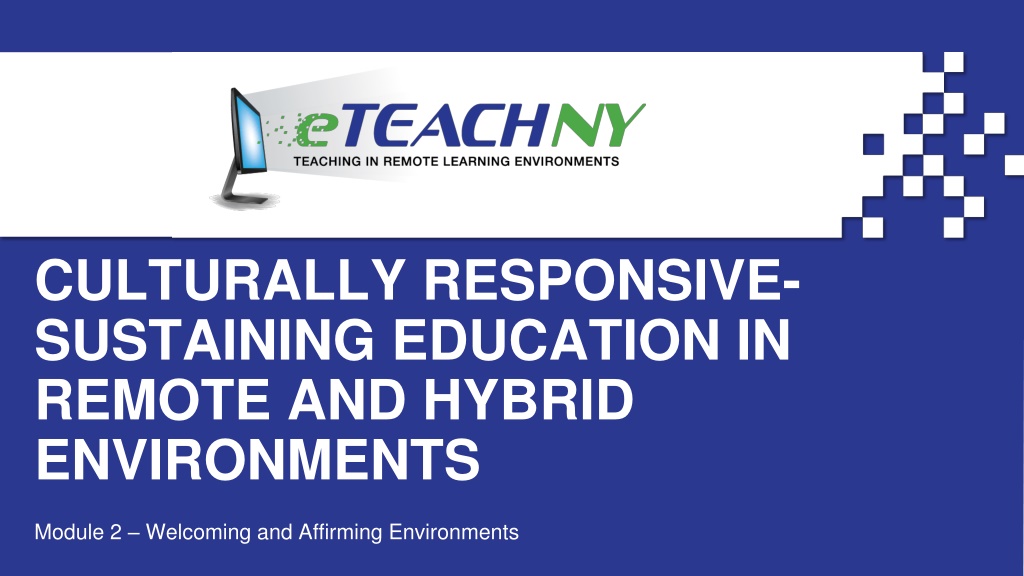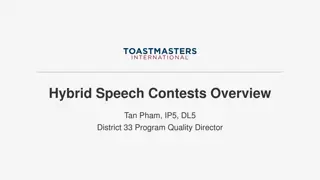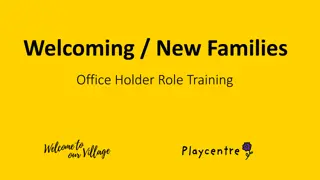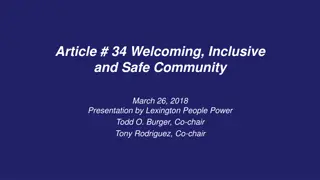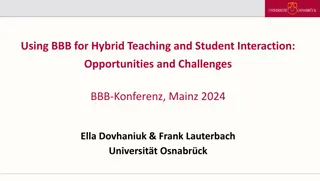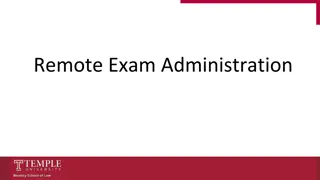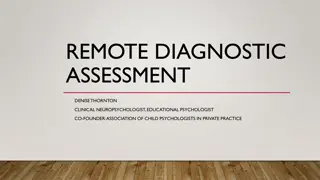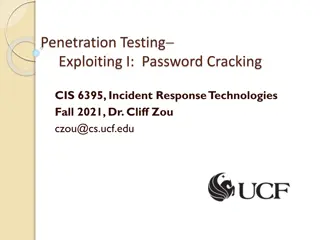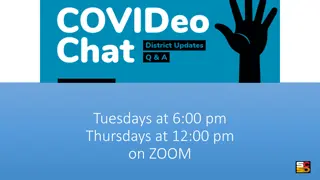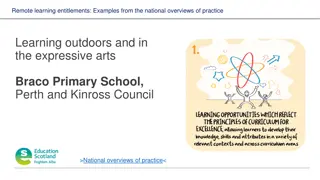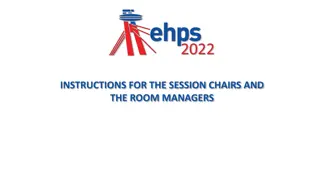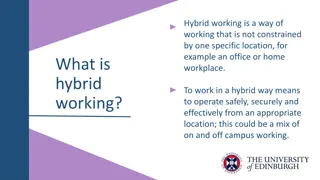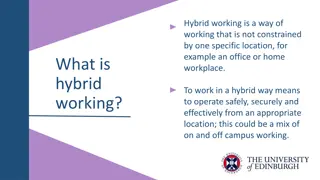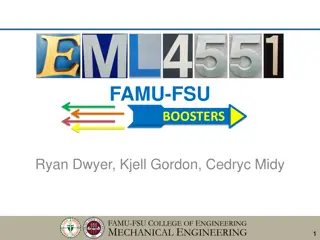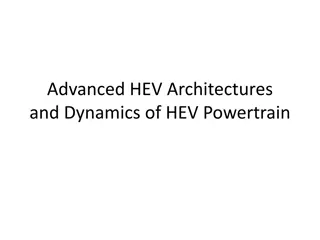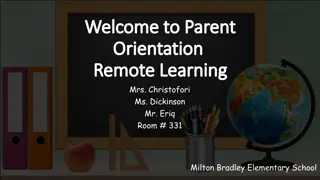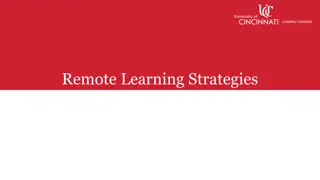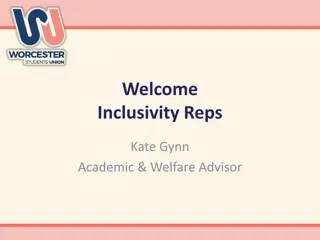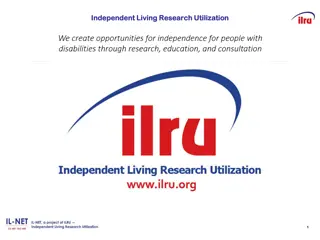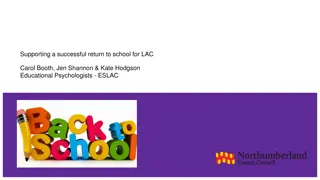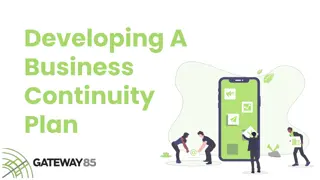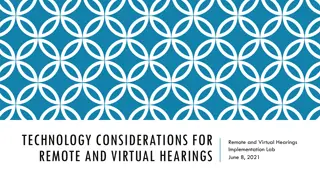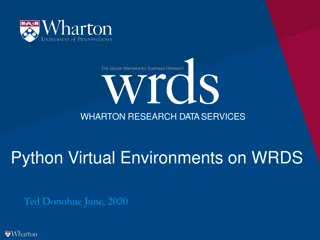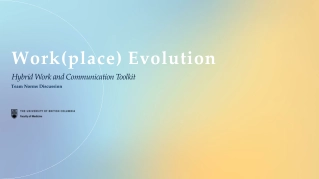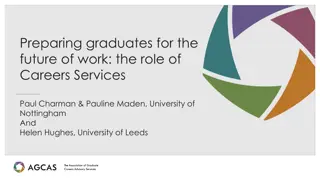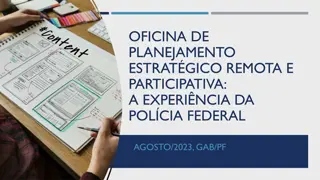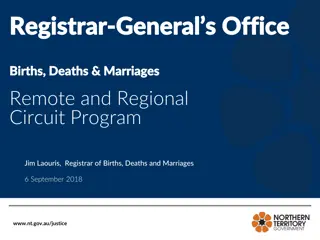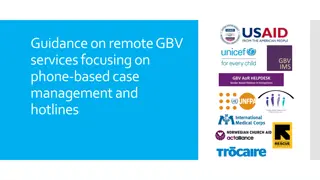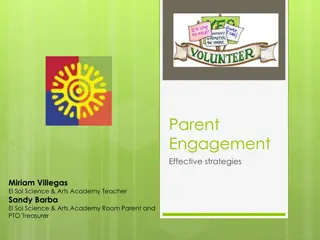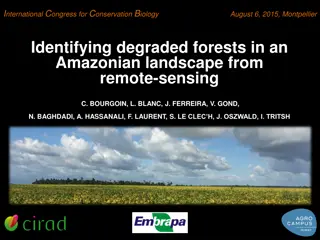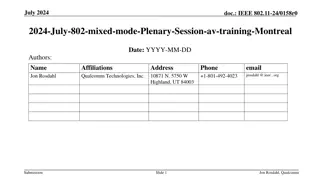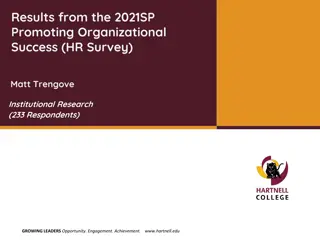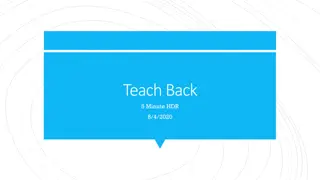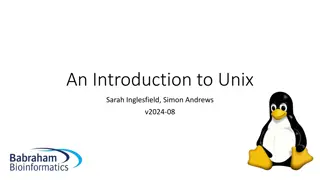Creating Welcoming Environments in Remote and Hybrid Education
This module explores the importance of creating welcoming and affirming environments in remote and hybrid educational settings. Through immersive scenarios, it prompts reflection on the impact of initial interactions on individuals entering a new space. Emphasis is placed on fostering a sense of belonging and support for students in virtual learning environments.
Download Presentation

Please find below an Image/Link to download the presentation.
The content on the website is provided AS IS for your information and personal use only. It may not be sold, licensed, or shared on other websites without obtaining consent from the author. Download presentation by click this link. If you encounter any issues during the download, it is possible that the publisher has removed the file from their server.
E N D
Presentation Transcript
CULTURALLY RESPONSIVE- SUSTAINING EDUCATION IN REMOTE AND HYBRID ENVIRONMENTS Module 2 Welcoming and Affirming Environments
Immersive Scenario Part 1 Your dream job! Imagine you have landed your dream job in a top- notch organization. It is an entry- level position for now, but there is room for growth. You walk into the office for your first day, walk up to the front desk, and the front desk receptionist glances up from their phone call to eye you up and down and point to the seats next to the desk. How are you feeling in this moment? 2
Immersive Scenario Part 1- continued What are your thoughts? How are you feeling about the office and its people from this introduction? The front desk receptionist proceeds to hang up the phone. Hello, how can I help you? Hello, today is my first day working here. Oh, right. I ll walk you to your cubicle and let someone know you are here. You and the front desk receptionist proceed through the doors as they guide you to where your cubicle is located. As you walk through the office, a few people look up at you and smile. The rest continue to work at their desks. You, also, notice that each cubicle is the same and there is nothing on the walls around you. 3
Immersive Scenario Part 2 Alternatively . . . Your dream job! Imagine you have landed your dream job in a top-notch organization. It is an entry-level position for now, but there is room for growth. You proceed through the door into the office and, as you are escorted to your work area, the front desk receptionist shows you various areas of the office. Also, they introduce you to people sitting at their desks along the way, who smile and welcome you, offering to assist you in any way you need. You walk into the office for your first day and walk up to the front desk. The front desk receptionist stands and welcomes you by name. You notice that there are various posters, quotes, and plants throughout the office. After you choose your cubicle, your manager comes out to greet you, bringing a plant, a mug, and some other items for you. 4
Immersive Scenario Part 2 - continued What are your thoughts? How are you feeling about the office and its people from this introduction? What is different about this scenario compared to the initial scenario? 5
Immersive Scenario - conclusion Having a welcoming and affirming learning environment is important. As you imagined from both of the scenarios above, your initial thoughts and feelings as you enter a new space provide your brain with data about the interactions in that space. This is especially important for students as they enter a learning environment, specifically remote/hybrid learning environments. This module is intended to have you reflect on your remote/hybrid learning environment and create intentional opportunities for students to feel welcomed and affirmed. Let s get started! 6
Learning Objectives The Voice of Your Classroom Design a physical and virtual learning environment that presents a welcoming and affirming message. A Community of Learners Implement norms, protocols, and achievable expectations for individual success and mutual support, whether students are learning in school or at home. A Family Gathering Honor and leverage parents/caregivers as powerful partners in developing a welcoming and affirming environment for learning in school and at home. Failing Forward Is What Matters Establish structures and strategies that allow students to take learning risks without fear of failure, seeing failure as a step in the learning process. 8
The Voice of Your Classroom: Contents The Danger of a Single Story - To identify ways in which our learning environments can curate a single story of our learners. This activity includes a video, reflection questions, and a collaborative activity. Reality Pedagogy - To create a remote/hybrid learning environment that affirms and values students by creating partnerships within the class. This activity includes a video, reflection questions, and a design activity. Using Inclusive Virtual Backgrounds to Design Affirming and Welcoming Learning Environments - To design digital spaces that promote an affirming and welcoming environment by fostering a sense of community with the images you include. This activity includes an e-text, reflection questions, and a design activity. 10
Reality Pedagogy (30 45 min) Watch the screencast: Objective To create a remote/hybrid learning environment that affirms and values students by creating partnerships within the class. https://www.youtube.com/watch?v=2Y9tVf_8fqo Reflection questions AND/OR Brainstorm and Design activity 11
Stop and Think (Key: T - Teachers, SL - School Leaders, DL - District Leaders) If you were to ask students about their insights on your remote/hybrid learning environment, what would they tell you? (T, SL) Why is it important to empower students to use their voices? What might we learn? (T, SL, DL) When Dr. Emdin discusses co-teaching, what were your thoughts on how that could be integrated into your remote/hybrid learning environment? (T, SL) 12
Brainstorm and Design In a remote/hybrid learning environment, students and teachers are utilizing a new set of skills. The ways in which students interact with one another and you have taken on a different form; it is important to not only recognize this but value it. To provide a space for students to not only recognize their voice but use it, we need to know what they value and what their strengths are in order to capitalize on them. 13
A Community of Learners: Contents Building a Belonging Classroom - To synthesize strategies for creating a remote/hybrid classroom where all learners know they belong. This activity includes a video, reflection questions, and a design activity. Introverted or Extroverted Energy Seekers - To identify students, and yourself, as those who seek energy internally (through their inner thoughts) or externally (by interacting with people) and to design appropriate collaborative protocols. This activity includes an e-text, reflection questions, and a design activity. Implementing a Great Hybrid-Learner Rubric - To design and implement a work-habits and behavioral rubric that sets, models, and reinforces classroom expectations. This activity includes a resource, reflection questions, and a design activity. Signaling Intent in a Remote/Hybrid Discussion - To generate ways for students to engage in discussion in a remote/hybrid learning environment. This activity includes a resource, reflection questions, and a collaborative activity. Establishing Norms and Protocols in Remote/Hybrid Learning - To establish mutually agreed-upon norms and protocols that will encourage students to act out of a sense of personal responsibility. This activity includes a resource, reflection questions, and a design activity. 15
Signaling Intent in a Remote/Hybrid Discussion (30 45 min) When considering your videoconference platform, note if there are built-in reaction emoticons and how you will have students use them during small- or whole-group discussions. Another alternative that may provide additional reactions is to create your own similar to the symbols shared above (they can be printed and cut out). Objective To generate ways for students to engage in discussion in a remote/hybrid learning environment. In the midst of a discussion, students can hold up an image to represent that they have something to add, that they are in disagreement, or that they have a question. This allows students to communicate in nonverbal ways, which is an important aspect of a discussion in an online environment, where delays could have students talking over one another. This is a great way to have students signal that they would like to speak or that they desire clarification. Reflection questions AND/OR Collaborate activity It also has the bonus benefit of helping English Language Learners associate an image with a concept, such as agree, disagree, question, and more. (Sulla, 2021) 16
Stop and Think: Virtual Discussions (Key: T - Teachers, SL - School Leaders, DL - District Leaders) Why is having virtual discussion symbols important? (T, SL, DL) How could you or your team begin to implement them with students? (T) What connections, if any, do you see between using virtual discussion symbols and social-emotional learning (SEL) strategies? (T, SL, DL) How could the virtual discussion symbols be used during faculty or team meetings? (SL, DL) 18
Collaborate As a content pair or grade-level team, create a discussion activity that would allow for students to engage with the use of the virtual discussion symbols. The activity can be content-based or focused on building community in your virtual learning environment. 19
A Family Gathering: Contents CRSE Family Engagement Strategies - To provide structures and strategies that promote family engagement in remote/hybrid learning environments. This activity includes a video, reflection questions, and a collaborative activity. Developing a Home-Based Learning Environment - To investigate a few different websites related to tips for home-based learning strategies to share with parents/caregivers. This activity includes website exploration, reflection questions, and a design activity. 21
Developing a Home-Based Learning Environment (25 30 minutes) 5 Things Parents [Caregivers] Can Do to Support Students Online Objective To investigate a few different websites related to tips for home- based learning strategies to share with parents/caregivers. Parent [Caregiver] Tips and Tricks for Distance Learning Reflection questions AND/OR Brainstorm and design activity 8 Elements of Home- Based Learning 22
Stop and Think: Strategies and Tips (Key: T - Teachers, SL - School Leaders, DL - District Leaders) Which of the strategies and/or tips that you wrote down above will you compile to fit the needs of your student and family population? (T, SL) How will you share the strategies and/or tips with them? (T, SL) How will you partner with parents/caregivers to support implementation? (T, SL, DL) What are some universal strategies and/or tips that will work for the entire school or district? (SL, DL) How can you engage parents/caregivers in a conversation about home- based learning strategies and/or tips from the beginning? (T, SL, DL) 23
Failing Forward is What Matters: Contents Strength-Based Thinking in Remote and Hybrid Environments - To leverage strength-based thinking in remote/hybrid learning environments to affirm and celebrate the diverse experiences and perspectives in your community of learners. This activity includes a video, reflection questions, a design activity, and a collaborative activity. Utilizing Restorative Justice Strategies - To explore and brainstorm ways to integrate restorative justice practices into your learning environment. This activity includes website exploration, reflection questions, and a design activity. 26
Strength Based Thinking in Remote and Hybrid Learning Environments Watch the screencast: Objective To leverage strength-based thinking in remote learning environments to affirm and celebrate the diverse experiences and perspectives in your community of learners. https://youtu.be/vFxGtYDPXro Reflection questions AND/OR Brainstorm and design activity 27
Stop and Think: Strength Based Thinking (Key: T - Teachers, SL - School Leaders, DL - District Leaders) What assumptions have you made about the sources of your learners struggles and motivations? (T, SL, DL) Are there any current school practices or traditions that reinforce these assumptions? (T, SL, DL) How do you currently engage families and community members in your remote learning environment? What ideas do you have for increasing meaningful engagement? (T, SL) What opportunities are there for community members to share their strengths with schools and learners in your remote learning environment? (T, SL, DL) What role do students play in setting their own goals for remote and hybrid learning? (T, SL) How can a culture of high expectations challenge deficit thinking? (T, SL, DL) 28
Brainstorm and Design: Strength Based Thinking Consider how you could use the goal setting strategies below to promote strength-based thinking and maximize student achievement in your classroom. Communicate learning goals clearly, before instruction. Goal setting is more likely to be effective in learning environments where students understand what they are learning and how they can show they have been successful. Offer opportunities for students to demonstrate understanding in multiple ways. Break larger goals down into intermediate goals. Students should understand the specific steps needed to reach the challenging goal. Intermediate goals reinforce motivation because progress towards intermediate goals shows students that they can be successful and encourages feelings of self-efficacy. Focus on process-based mastery goals over outcome-based performance goals. Performance goals imply two outcomes: success or failure. All students can achieve skill-based goals at their level. Mastery goals emphasize the process of learning, self-improvement and new skills acquisition. Use self-assessment, self-reflection and peer feedback regularly. These strategies increase students self-efficacy and achievement. Efficacious students choose more difficult goals and show greater commitment to their goals. They are more resilient to setback and failure, increasing their effort to achieve the goal. Use carefully targeted feedback. Feedback is one of the most powerful tools we have to improve learning. High quality feedback is instructive, specific and not overwhelming, timely, and nurtured in a supportive, collaborative environment. 29
Strength Based Thinking in Remote and Hybrid Learning Environments: Begin Exploring a Learning Dashboard Collaborate Explore a Learning Dashboard as a tool to support goal setting and self-assessment. Like a car dashboard, a learning dashboard offers students and teachers an up- to-date snapshot of progress. The sample dashboard on slide 9 lists skills from 3rd grade curricular standards and allows the teacher or student to designate if a student is "Just Learning," "Practicing," or at the "I Got This!" stage with cells that are conditionally formatted. 30
Strength Based Thinking in Remote and Hybrid Learning Environments: Explore a Learning Dashboard Try it! Click on one of the linked Learning Dashboard templates below. Next to a standard, under one of the columns, type in an x and hit the enter/return key. Notice how the box turns the column color? Microsoft Excel Learning Dashboard Template Google Sheets Learning Dashboard Template 31
Strength Based Thinking in Remote and Hybrid Learning Environments: Explore a Learning Dashboard Imagine a student looking at his or her dashboard and having this visual to support their goal setting, self-assessment, and progress. Even if the teacher is the one entering the data, the dashboard should be shared with students so they can play a role in identifying and working toward intermediate goals. Reinforce the power of failing forward! Use setbacks as learning opportunities by using the Learning Dashboard as a tool to frame meaningful conversations with your learners. The first step to implementation is to identify the standards/objectives for the content area(s) being tracked and complete the template for your class, grade level, or department. Then, create a copy for each student. You may choose to include intermediate goals based on each learner's individual needs. Or, use the practicing column as an intermediate goal that students can work towards at first. 32
Learning Objectives: Summary The Voice of Your Classroom Design a physical and virtual learning environment that presents a welcoming and affirming message. A Community of Learners Implement norms, protocols, and achievable expectations for individual success and mutual support, whether students are learning in school or at home. A Family Gathering Honor and leverage parents/caregivers as powerful partners in developing a welcoming and affirming environment for learning in school and at home. Failing Forward Is What Matters Establish structures and strategies that allow students to take learning risks without fear of failure, seeing failure as a step in the learning process. 33
CULTURALLY RESPONSIVE- SUSTAINING EDUCATION IN REMOTE AND HYBRID ENVIRONMENTS Module 2 Welcoming and Affirming Environments
